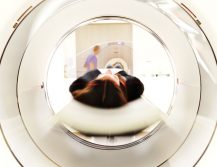
A compression fracture in one of your vertebra can cause debilitating pain. When the bone fragments rub against each other, even the slightest move can cause discomfort. Fortunately, there is a solution that can provide the relief you seek – kyphoplasty.
What Is Kyphoplasty?
Kyphoplasty is a minimally invasive surgical procedure that’s used in combination with vertebroplasty. During vertebroplasty, your doctor will inject a cement mixture into the fractured bone to reinforce its structural integrity. Kyphoplasty is the treatment that makes room for the mixture. Your doctor will insert and inflate a balloon to create an opening. The balloon is removed after the injection.
Both procedures are more likely to relieve pain and improve mobility if done within two months of a fracture diagnosis.1
Am I a Candidate for Kyphoplasty?
Kyphoplasty is often recommended for people who have cancer that’s damaged their vertebrae or those whose vertebrae have collapsed because of osteoporosis. It isn’t used as a preventive technique and usually isn’t advised for people with arthritis, herniated disks or scoliosis.
The procedure is typically done in older adults, as the long-term effects of bone cement haven’t been studied extensively enough to use in younger adults.2
Preparing for Kyphoplasty and Vertebroplasty
Your doctor will likely order blood tests beforehand to see if you’re healthy enough for surgery. X-rays or MRI scans will also help your surgeon see the areas that need repair.
On the day of the surgery, an IV will be placed in one of your veins to deliver anesthesia, and you may also be prescribed pain and anti-nausea medications and antibiotics. Once everything is ready, your surgeon will:
- Insert a hollow needle into your skin and guide it to the correct position in the injured bone.
- Insert an inflatable balloon into the needle.
- Inflate the balloon to make space for the cement.
- Inject the mixture into the open space.
- Remove the needle after the cement is in place.
- Bandage the area – stitches aren’t necessary.
The procedure takes about an hour for each vertebra involved. Afterward, you’ll be closely monitored for signs of complications. Most patients can go home the same day.3
Recovery Process
Your doctor may encourage you to get up and walk for an hour after the surgery. You’ll likely feel soreness for a few days, which is normal, but you may notice that the pain from the fracture has diminished.4 Ice packs and pain medications can help relieve any immediate soreness.
Talk with your doctor to determine whether you should avoid any activities after the procedure, or if you need to take certain vitamins or medications to strengthen your bones and prevent future fractures.
What Are The Risks of Kyphoplasty?
Like all surgical procedures, kyphoplasty comes with some risks, such as infection or a reaction to anesthesia. Other complications specific to this surgery include:
- Nerve damage or spinal cord injury from mispositioned instruments or a cement mixture leak
- Allergic reaction
Though nearly 75 percent of patients experience less pain and greater mobility after kyphoplasty, about 10 percent of patients develop additional compression fractures.5
Comprehensive Spinal Care in Dallas-Fort Worth
Minimally invasive procedures like kyphoplasty can help you get back to living pain-free with little downtime. Spine Works Institute offers the latest in minimally invasive spine surgeries and comprehensive spine treatments, including physical therapy and steroid injections, that can provide the pain relief you desire. Call us today at 817.616.0700 to schedule your appointment.
1 https://www.healthline.com/health/bone-health/kyphoplasty
3 https://www.spine-health.com/treatment/back-surgery/description-kyphoplasty-surgery
4 https://www.hopkinsmedicine.org/healthlibrary/test_procedures/orthopaedic/kyphoplasty_135,36
5 https://www.radiologyinfo.org/en/info.cfm?pg=vertebro








